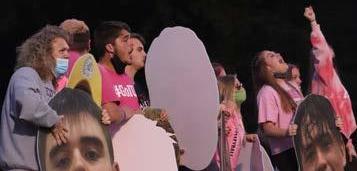
4 minute read
Pandemic impacts athletic budget | Sports programs allow for greater physical activity for younger students
Hailee Bowen | staff writer
The COVID-19 pandemic not only impacted the audience numbers at athletic events, but it also hurt the bottom line of the athletic department’s budget.
Advertisement
“Currently, we only get what little money comes in the gate at home contests. On average under red advisory and limiting to just immediate households, we will lose almost $200 on average at each contest after we pay workers and officials. We have gotten a little sponsorship money but not much at all compared to previous years,” athletic director Jamie Lowry said.
Sponsors — local and area businesses and organizations — have been in a difficult situation themselves. Many businesses have not had their typical amount of business income, making it difficult to support others. However, the athletic department held a fundraiser to help generate funds lost due to spectator COVID-19 restrictions.
“We did have one fundraiser recently where I was fortunate enough to get my hands on a PS5 that we raffled off. That helped tremendously. That will help get us through the winter sports season,” Lowry said.
To allow fans an opportunity to watch the games this year, the athletic department teamed up with NFHS Network to host the games online. The streaming service provides a portion of its costs back to the athletic department.
“Our live streaming also gets us a little funding, but not enough to offset the loss of each home game. Sponsors are very hesitant right now. Many haven’t responded back to me like they have in the past and the ones that have are either not sponsoring this year due to their budgets or have given a much smaller amount,” Lowry said.
The building back up of money is going to be a difficult road. The consequences aren’t going to be pretty, but it’s something that has to be done.
“There will have to be cuts and teams that were scheduled to get uniforms will have to wait a while longer to purchase,” Lowry said. “It’s hard to make up the loss of one major season though. We are planning a couple big fundraisers for the spring and summer that will hopefully get us back in the right direction.”
For the future, Lowry remains hopeful the fans will return as the pandemic resolves.
“I think you will see a slow return of fans when it opens back up,” Lowry said. “Many have subscriptions and may just watch the games at home now all the time. I know some fans are anxious to get back to the gym, field, etc to see their sports though.”
Sports programs allow for greater physical activity for younger students
Hailey Christoff
In the last few years, Scott County School District 2 has made youth sports available to elementary students with the addition of basketball, volleyball, cheerleading, track and field, and soccer. The Scott County Youth Football League offers flag and tackle football for elementary students. Not only do these programs provide health benefits from exercise, but the elementary sports become feeder programs for high school sports teams.
With the changes to adding in school sports at a younger age, the evolution of physical education electives at a younger age might follow to allow younger student-athletes similar options of their high school student-athlete counterparts.
“I think physical education should start earlier. If you start it at a younger age then you are able to figure out what you like and what you don’t like,” said freshman Haley Thomas, who plays girls varsity basketball and softball. “This way, you can have more time to practice your activity, and by the time high school rolls around, you should be prepared for anything.”
Currently, in high school, physical education becomes an elective unless a student fails the course or did not take the course in eighth grade. The high school physical education program offers elective classes with coed and female-only options in the recently remodeled weight room.
“I don’t think a PE program would be good for the high school. Students have the choice to play a sport or to take a weights class,” Carly Helton (11) said.
Helton said requiring a PE class would not be beneficial to those who do not need or want it.
While elementary students start their physical education journey with recess starting in kindergarten with time to play twice per day through fifth grade. Fourth- and fifth-grade students add in one physical education time to their rotation of specials offered to them, such as music, art, library time, science. Physical activity improves one’s muscle strength, endurance, delivers oxygen and nutrients to one’s body, and promotes better cardiovascular health, according to the Mayo Clinic website.
“I do not think that increasing physical education should be increased, as there are things such as recess and other activities where elementary school students can get physical activity in,” senior boys soccer midfielder Jackson Campbell said.
Avery Lytle (11) said he recognizes the advantages of establishing a physical education program for students who want to better themselves, physically.
“It benefits students by getting them active throughout the day. This builds motivation and self-esteem,” Lytle said.
Although Lytle is not in the weights class, he does work out with the football team after school.
If the school could not establish a physical education program, Lytle said the school should have a designated time where all students do something active for 30 minutes a day.






